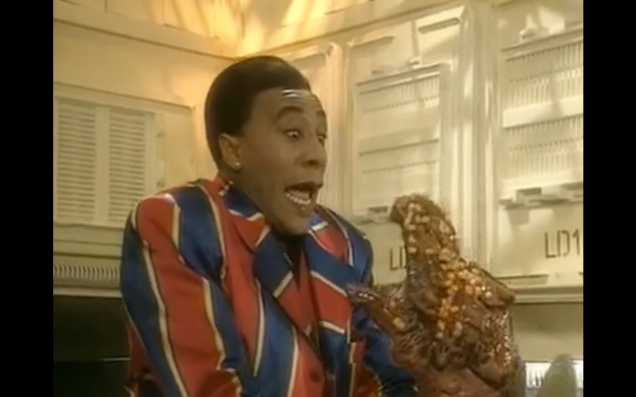 |
| Now to figure out which one is Chirpy Boy and Bart Jr. The madness! THE MADNESS! |
Airdate: September 27th, 1998
Synopsis: Bart kills a bird, raises it’s babies, and it turns out it wasn’t the bird’s babies that he was raising.
More specifically, Bart defies his mother by hanging out with Nelson, who just acquired a BB gun at an arcade. One false move, and not only is a bird dead, but Marge finds out and decides to give up on trying to interact with him. Feeling utter guilt, Bart decides to raise the eggs as his own… and lizards wind up hatching.
Review: Ah, ZZZZZZ… oh, sorry, where was I? Oh, yeah, this episode. A pretty blasé, boring half hour… well, the first two acts, anyway. The third act, I don’t know what happened.
The first part of the episode is so boring, that I don’t think I’m gonna go in depth here. This might be my shortest review since I don’t even know when.
Basically, the first two acts are “Marge Be Not Proud”… but with BB guns and birds instead of video game theft and christmas. I think the use of Nelson was an attempt to show how bad first impressions can be, except that, it actually makes sense that Marge wouldn’t be a fan of Bart hanging out with Nelson. That, and at least “Marge Be Not Proud” actually used subtle emotions, instead of the dramatic over-explaining in this episode… as if the audience were too stupid to know that Marge was fed up.
What a sea change.
Not only that, but I think the character traits explored have been handled better in previous episodes. Marge’s over-protective, somewhat hypocritical principles were already touched upon in “Itchy and Scratchy and Marge”. Bart’s own self-doubt was already hit upon in “Bart Gets an F”, and his relationship with his mother, “Marge Be Not Proud”. All of these episodes handled those conflicts in more complex, interesting ways.
The moments after Marge gives up are definitely better – not that much, but still. Bart, feeling guilt, raises the bird for himself. While I don’t think Bart feeling a certain level of guilt is out of character (I refer you to “Sweet Seymour Skinner’s Baadasssss Song”, and his guilt over getting Skinner fired), here, it goes a bit too over the top, and thus, feels a bit out of character for him. Or maybe the episode’s boring-ness got to me. That, and it did give us a gold Troy McClure film strip… unfortunately, it would be the last ever. (See below.)
Now, the third act is actually pretty decent. As wacky a twist it was, the reveal of the lizards actually added some strange sense of life into this episode. Plus, having Bart try to defend his lizards actually creates an interesting parallel. In the end, I think that “Bart the Mother” was trying to put Bart in Marge’s shoes – that he will still defend what, to an extent, are his children, even if they give people some hell.
Oh, and I did like the twist on environmental balance. The lizards were an invasive species who were killing off other animals. To an extent, this provides the question – is it part of the circle of life? Are we really doing harm by leaving these animals/reptiles be? As far as I know, this environmental analysis was unintentional, much like the ending to “Trash of the Titans”, another episode that I have mixed feelings for. Kinda cool that we aren’t in the anvil dropping zone yet, that the writers can still do subtle social commentary.
Too bad this episode wasn’t that memorable.
Let’s just wrap it up here – it’s a rather boring episode. Sadly, I think it could’ve been sweet if it didn’t take a path that was far too similar to “Marge Be Not Proud”, and syphon the comedy from that episode. Analyzing Bart isn’t a bad thing, but they’ve done it quite a bit better. (Take a look at “Bart Gets an F”, or “Bart Sells His Soul”.) It passes, but that’s more because nothing in this episode really offended me.
Tidbits:
- Interestingly, Nancy Cartwright has cited this as among her most-loved episodes, because of the soul searching. Not gonna bash her opinion… just disagree with her.
- This was the last episode written by David Cohen before he left to create Futurama with Matt Groening. Interesting that around the same time Futurama premiered, The Simpsons began its fall from grace.
- On a more somber note, as I alluded to above, this was also the last episode to feature Phil Hartman – this time, in the aforementioned Troy McClure film strip. For those unaware, on May 28th, 1998, Hartman’s wife shot him three times before turning the gun on herself. A coroner’s report suggested that she was under the influence of drugs. It was a shocking and grisly end, and silenced one of the greatest comics of the 80s and 90s. Out of tribute, the writers decided to silence their characters. For that, I give Mike Scully respect. Similar props to Al Jean, for keeping it up with Hartman’s characters.
Favorite Scene: The Troy McClure script. You will be missed, Phil.
Least Favorite Scene: Marge turning her back on Bart was done far better in “Marge Be Not Proud”, mainly because of subtlety.
Zaniness Factor: 2.5. Lizards? Really?
Jerkass Homer Meter: 1.5 – mainly for getting beaten up at the batting cage. Granted, I did like the lightbulb gags.
Score: 5.5










You must be logged in to post a comment.